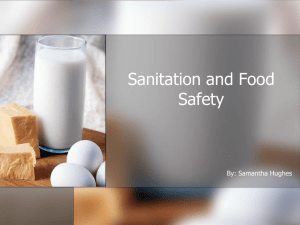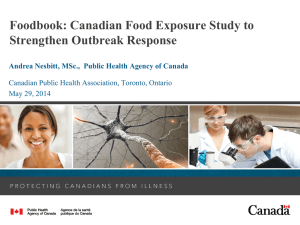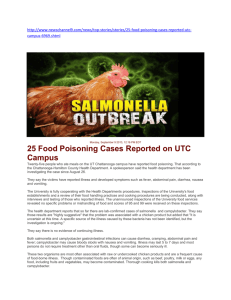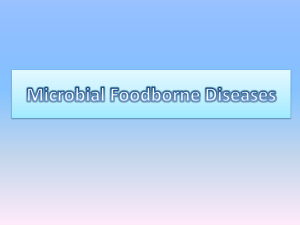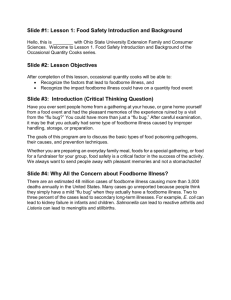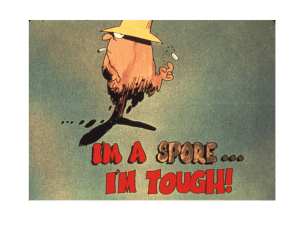Chapter 25 Keeping Food Safe
advertisement
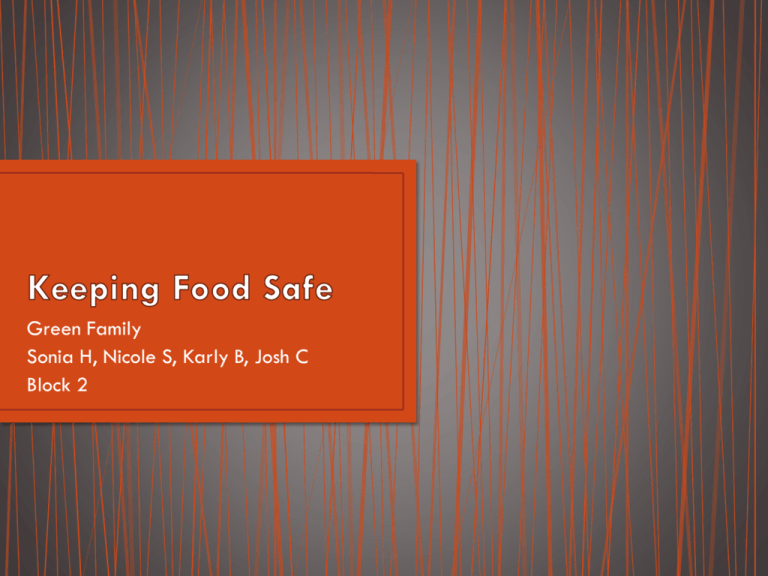
Green Family Sonia H, Nicole S, Karly B, Josh C Block 2 Vocabulary Objective • Name and describe the microorganisms that cause food to spoil • Differentiate between food intoxication and food infection • Identify sources and symptoms of foodborne illnesses • Explain the role of various government agencies that keep the food supply safe • Demonstrate steps to prevent the spread of foodborne illnesses • Assess the safety of food preparation methods • • • • • • • • • • • Adulterated Botulism Cross-contamination Food Infection Food Intoxication Foodborne Illness Parasites Pathogenic Pesticides Residue Spores • Food Borne Illness: An illness caused by eating food that has been contaminated in some way There are 3 Microorganisms of Food Illness Molds: aerobic organisms that tell you food is going bad, but are usually more wasteful than harmful Yeast: One-celled plant, and use spores to survive harsh conditions Moldy Bread Spores: Microorganisms in a dormant, inactive, or resting state Bacteria: Most threatening, even though only 20 bacteria cause foodborne illness, can grow aerobically or anaerobically. Only die at certain temperatures Yeast Spores Bacteria • Food Intoxication: A bacterial foodborne illness that occurs when microorganisms grow in food and produce a toxin there. The toxin causes the illness when the food is eaten. Types of Bacteria that Will Cause it • Clostridium Perfringens : Grow naturally in your intestine, but if ingested in large numbers can cause sickness. Might grow on food left out at room temperature. • Staphylococcus Aureus: Commonly known as a staph infection , and is usually brought in from a human source, and improperly stored meats. • Clostridium Botulinum: Grow in contaminated fish, and poorly stored cans… can cause botulism • Botulism: a very serious – and sometimes fatal – form of food poisoning Staph Infection • Food Infections: Bacterial borne illness that occurs when pathogenic microorganism enter the body with the food. • Pathogenic: Disease carrying Types of Bacteria that Will Cause it • Salmonella Enteritidis: Occurs mainly in undercooked eggs, but can occur in most undercooked meats. It can come from cross-contamination, and causes illness. • Cross Contamination: the transfer of bacteria from one food to another • Escherichia Coli: Commonly known as a E. Coli it lives in animals, but will infect a person if the food isn’t cooked properly. It can cause death by attacking cells. • Listeria Monocytogenes: Found in the soil, but if ingested can cause sickness, it lives harmlessly in animals, but is harmful when passed on through to people Illness Cause Symptoms Sources Prevention Clostridium Poisoning Toxin produced by Clostridium Perfringens Stomach Cramps, Chills, Headache, Diarrhea Meat, Poultry, Hot foods cooled to room tempurature Keep hot foods hot, refrigerate uneaten foods Staph Infection Toxin produced by Staphylococcus Aureus Severe Vomiting, Stomach Cramps, Diarrhea Botulism Toxin produced by Clostridium Botulinum Nausea, Vomiting, Diarrhea, Fatigue, Double Vision, Muscle Paralysis, Lung Failure Low-acid canned foods, honey (for infants) Heat canned foods thoroughly, do not give infants honey Salmonellosis Infection by Salmonella Nausea, Fever, Diarrhea, Ab Pain, Headache, Meat, Poultry, Eggs, Milk, Cross contamination Cook foods thoroughly, follow sanitation rules E. Coli Poisoning Infection by Escherichia coli 0156:H7 Diarrhea, Brain Damage, Kidney Failure, HUS Undercooked beef, unpasteurized milk Cook beef thoroughly, follow sanitation rules Listeriosis Infection by Listeria Monocytogenes Fever, Chills, Nausea, Miscarrige Soft Cheese, ready to eat deli meats Heat ready to eat meats to steaming, avoid likely foods Moist, cooked meat Refrigerate uneaten dishes or starches at foods room temperature • http://education-portal.com/academy/lesson/what-is-afoodborne-illness-definition-and-common-types.html#lesson (8:00min.) • Parasites: organisms that grow and feed on other organisms • Comes form improperly cooked foods • Viruses • An infected person can pass it on form person to person Destroying Angel Mushroom • Pesticides: Chemicals used to kill insects, animal pests, and weeds • Can still be on foods if not stored or processed properly • Natural Toxins • Stuff found in mushrooms that are not safe and can cause death within hours Common Cold Virus • Few Laws that check for Adulterated foods • Adulterated: Made impure by the addition of improper ingredients • Agencies check for residues • Residues: The matter remaining after a chemical or physical process • 4 Major Agencies • • • • FDA: Food and Drug Administration United States Department of Agriculture President’s Council on Food Safety International Agencies United States Department of Agriculture • Practice Cleanliness • Wash your hands • Store Food Safely • If it needs to be frozen freeze it • Handling Food with Care • Do not cross-contaminate foods • Use expert advice • Prepare Foods Properly • Wash fruits and veggies • Cook meat thoroughly • http://www.teachertube.com/viewVideo.php?video_i d=272127
